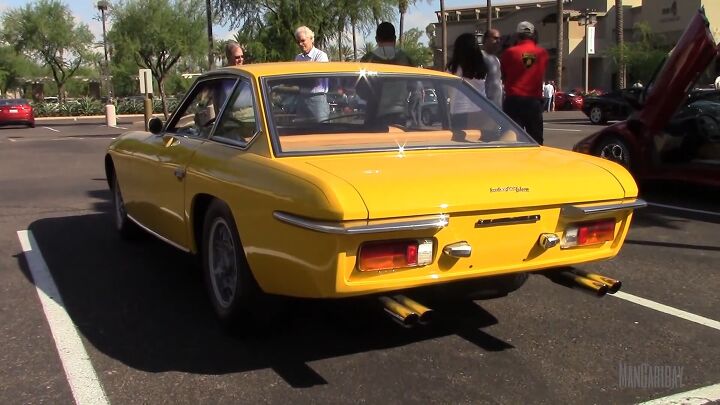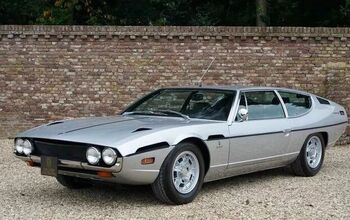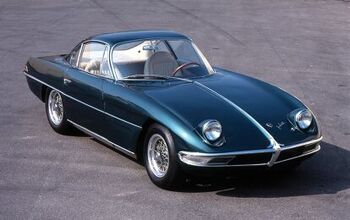Rare Rides Icons: Lamborghini's Front-Engine Grand Touring Coupes (Part VII)

When we last left Lamborghini’s front-engine coupe timeline, Ferruccio Lamborghini found himself about out of time to designate a replacement for the 400GT 2+2. Touring’s Flying Star II two-seat shooting brake was radical and possessed neither the restrained GT styling Mr. Lamborghini desired, nor the full four-place capacity. The company turned to Bertone and design legend Marcelo Gandini, who proposed the four-seat Marzal.
The Marzal’s design was as radical as the Flying Star if not more, and had gullwing doors and an interior filled with silver textile. After it debuted Ferruccio remarked how the Marzal was just a fun design exercise and was not intended to be a production car. Whether that statement was actually true remains unclear, but seems unlikely given the events that occurred post-Marzal. Lamborghini needed a real production design, and fast.
To that end, Ferruccio decided to take a more in-house approach to its GT coupe project. He wasn’t having any luck with external designers and had been through three firms including the Neri & Bonacini 400GT Monza. To fix the issue, he’d bring design talent into the office and would work with the designer and Lamborghini’s engineers in a group project.
As mentioned previously, Lamborghini’s rejection of the Flying Star II was a death kiss for Carrozzeria Touring, which closed its doors shortly thereafter. But Ferruccio did not wipe Touring’s design skill from his mind entirely: When he went looking for a designer to hire and bring to Lamborghini’s HQ, Mario Marazzi was near the top of his list. Marazzi was a Bertone employee but had worked for Touring in the recent past. Given Touring was a bust, Marazzi took initiative and started his own firm, Carrozzeria Marazzi (1967-2019).
Founded in Milan with Carlo Marazzi as its CEO, the firm also employed Carlo’s two sons, Serafino and Mario. The rest of the staff roster was filled with the talented people who formerly worked at Touring. Lamborghini hired Marazzi, and the small company embarked on a design project with direct CEO and engineer input.
Mister Lamborghini had learned his lesson about designers with autonomy, first with the 350GTZ that couldn’t fit the company’s V12 under its hood, then from the Flying Star II and Marzal that were too wild to produce. History reports that with the fourth coupe design, Ferruccio dictated his exacting requirements to Marazzi at the Lamborghini offices and oversaw the entire project directly.
Work started on the new Lamborghini almost immediately after Marazzi founded his new company, and continued on through early 1968. What the staff at Marazzi realized in short order was that Mr. Lamborghini wanted a sort of evolution of the extant 400GT, rather than an all-new design. To that end, the underlying formula changed very little between the two cars.
One thing that did change was the company’s coupe naming scheme. At the conclusion of the 400GT, Lamborghini stepped away from model naming that started with a number. Lamborghinis from 1968 to the present day wear various names or adjectives, with a singular exception in the LM002 SUV. The new grand tourer would be called Islero, the name of a fighting bull that killed the matador Manolete in 1947.
The Marazzi design that resulted from Lamborghini’s strict instructions was more angular and modern looking than the 400GT but lost some of its flair. The Islero’s hood was mostly smooth and interrupted only by an air scoop near the windshield. The hood’s opening itself was smaller than one might expect, and fenders wrapped over the front end and toward the middle to meet the hood shut line. The fenders had a strong upper edge on either side, which drew the eye downward as they came to a point at the edge of the front clip.
The 400’s upright quad headlamps were replaced by concealed ones in the Islero, hidden behind pop-up panels. The front clip as a whole was more aerodynamic looking than on the 400, and a thin chrome bumper appeared and made the front end look more linear. The bumper wrapped around the front end and terminated just below an amber indicator light in the fender.
Underneath the bumper was a mostly unadorned grille that had a thin chrome perimeter, and contained both fog lamps and driving lamps. In the lower valance were two ovoid port holes which looked like they might have been the originally intended place for the driving lamps. The Islero’s front clip was a very large piece of aluminum: A singular piece included both fenders, much of the hood area, and the wheel wells, and ran back to the A-pillar.
Like the 400 the Islero’s side profile was a teardrop shape, though more upright. Adornment and trim along the side were minimal and included a soft character line that ran along the fender and above the wheel and door handle, and a rectangular porthole decoration behind the front wheel (on some examples). From the side, the Islero was notably taller looking than the 400, and its roof line was more formal.
The Islero had a C-pillar with a sharper angle that was less dramatic looking than the 400. It wrapped around a squared-off rear side window of a trapezoidal shape. The rear window of the Islero was much larger than on the 400, an attempt at better visibility. All these design cues set the stage for a rear serious and conservative rear deck that angled downward toward the tail lamps.
Rear bumpers on the Islero were placed above the exhaust and tail lamps, which rendered them ineffective as bumpers. Rear light clusters were taken from (I believe) a contemporary Fiat and looked a bit out of place. Quad rear exhausts were tucked up under the rear valance, and did not protrude straight outward as they did on the 400. The Islero rode on a new slotted Campagnolo wheel design, which replaced the wires of the 400.
The Islero received an interior that was updated slightly from the 400 but retained much of the same theming. Large dials in front of the driver grew in number and were backed with wood trim. The central cluster of four dials and warning lights vanished; both were integrated into the gauge cluster. Large switches on the center stack were fewer in number than they were before, but of the same basic layout as on the 400.
The Islero had a more modern dash shape than the 400 with its edges and angles and was sculpted to form a small shelf in front of the passenger. As before, the passenger had exclusive access to the radio controls. Elsewhere in the interior, the theme of ribbed leather and comfortable flat bucket seats remained. The Islero had a roomier interior than the 400 and was intended to be much more user-friendly. However, Lamborghini lost the battle for a four-seater as the Islero’s rear seating arrangements were still in the +2 category.
With its new design complete, Lamborghini needed to get the Islero finished quickly so it could make its debut at the Geneva Auto Show for 1968. The car that resulted was essentially a rebody of the 400 with the same mechanicals and chassis, as we’ll see in our next installment. However, even though the underlying parts were by no means new there were some new issues. They were the kind of issues that happen when a brand new coachbuilder is tasked with the construction of a high-end sporty coupe. See you next time.
[Images: Lamborghini, YouTube]
Become a TTAC insider. Get the latest news, features, TTAC takes, and everything else that gets to the truth about cars first by subscribing to our newsletter.

Interested in lots of cars and their various historical contexts. Started writing articles for TTAC in late 2016, when my first posts were QOTDs. From there I started a few new series like Rare Rides, Buy/Drive/Burn, Abandoned History, and most recently Rare Rides Icons. Operating from a home base in Cincinnati, Ohio, a relative auto journalist dead zone. Many of my articles are prompted by something I'll see on social media that sparks my interest and causes me to research. Finding articles and information from the early days of the internet and beyond that covers the little details lost to time: trim packages, color and wheel choices, interior fabrics. Beyond those, I'm fascinated by automotive industry experiments, both failures and successes. Lately I've taken an interest in AI, and generating "what if" type images for car models long dead. Reincarnating a modern Toyota Paseo, Lincoln Mark IX, or Isuzu Trooper through a text prompt is fun. Fun to post them on Twitter too, and watch people overreact. To that end, the social media I use most is Twitter, @CoreyLewis86. I also contribute pieces for Forbes Wheels and Forbes Home.
More by Corey Lewis
Latest Car Reviews
Read moreLatest Product Reviews
Read moreRecent Comments
- Spectator Wild to me the US sent like $100B overseas for other peoples wars while we clammer over .1% of that money being used to promote EVs in our country.
- Spectator got a pic of that 27 inch screen? That sounds massive!
- MaintenanceCosts "And with ANY car, always budget for maintenance."The question is whether you have to budget a thousand bucks (or euro) a year, or a quarter of your income.
- FreedMike The NASCAR race was a dandy. That finish…
- EBFlex It’s ironic that the typical low IQ big government simps are all over this yet we’re completely silent when oil companies took massive losses during Covid. Funny how that’s fine but profits aren’t. These people have no idea how business works.






































Comments
Join the conversation
Modern cars are better mechanically in every way compared to cars from the 1960s. But, and my age is probably showing here, the older ones are prettier.
Beauty
Soul
Class/elegance
Rarity
Expense.
Very interesting series